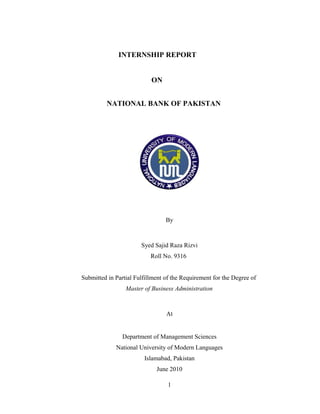17
This internship report summarizes the author's internship experience at the National Bank of Pakistan's Kamalia City branch. Some key findings include: employees lack computer skills and training, especially in the cash department; implementing new systems takes a long time; and human resource training programs are needed to update employees' skills. The report also provides details about NBP's history, organizational structure, banking services, schemes, policies and the author's observations of various departments at the Kamalia City branch. Financial analysis of NBP is included in annexures.




















![and at which it lends forms the source of its profit. A bank, thus, is a profit earning
institution”
“A bank, [bæŋk] is a business that provides banking services for profit. Traditional
banking services include receiving deposits of money, lending money and processing
transactions. Some banks (called Banks of Issue) issue banknotes as legal tender. Many
banks offer ancillary financial services to make additional profit; for example: selling
insurance products, investment products or stock broking.”
1.3 - IMPORTANCE OF BANKING
Banks play very important role in the economic life of a nation. The growth of the
economy is dependent upon the soundness of its banking system. Although banks do not
create new wealth but borrow, exchange and consume. These make generation of wealth.
In this way they become most effective partners in the development of that country.
To encourage the habit of saving and to mobilize these savings is its basic purpose. Banks
deposit surplus from the public and then advances these surpluses in the form of loans to
the industrialists, agriculturists, businessmen and unemployed people under different
schemes so that they set up their own business. Thus banks help in capital formation.
If there are no banks, then there would be concentration of wealth in few hands and great
portion of wealth of a country would be idle. In the fewer developing countries rate of
saving is very low and due to this, rate of investment and rate of growth is also very low.
We can take bank just like a heart in the economic structure and capital provided by it is
like blood in it. As long as the blood is in circulation, the organs will remain sound and
healthy. If the blood is not provided is not provided to any organ then the organ would
become useless. So if the finance is not provided to agriculture sector or to industrial
sector, it will be destroyed. Loan facility provided by bank works as an incentive to the
producer to increase production. Banks provide transfer of payment facility, which is
cheaper, quicker and safe. Many difficulties in the international payment have been
21](https://image.slidesharecdn.com/9c4f6222-52f0-40f2-ae89-78b9deb0387a-150624085418-lva1-app6892/85/sajid-21-320.jpg)







































![Basic salaries are provided in case of hospitalization and if employee himself or any of
his spouse, kids and his widow mother is hospitalized.
8.4 - APPROVED FUNDED GRATUITY SCHEME
NBP operates an approved funded gratuity scheme for all its permanent employees.
Contributions are made in accordance with the actuarial recommendations; the valuation
was carried out using the Projected Unit Credit Method in line with the requirements of
8.5 - International Accounting Standard 19, Employees Benefit
Provision is made annually to cover obligation under the scheme. Gratuity accruing to
staff is equal to one basic salary for each year completed of service. Payment of gratuity
is as follows: Where Completed Year of Service is:
Less than three years Nil
Three years 60% of gratuity amount
Four years 80% of gratuity amount
Five years 100% of gratuity amount
In case of death, payment of gratuity is
]Based on completed years of service 100% of gratuity amount
8.6 - BONUSES / STAFF LOANS
Bonuses are also given to permanent employees on their performance basis. In case of
very good performance 2 basic salaries are given and in any other case 1 basic salary
are provided as bonus.
8.7 - SIMPLE LOAN
Simple loans are also provided to permanent employees by the NBP. Three basic salaries
are provided as loan and it is for a period of three years. So loan is payable in 36 equal
installments including markup. Markup is calculated according to the formula. When an
61](https://image.slidesharecdn.com/9c4f6222-52f0-40f2-ae89-78b9deb0387a-150624085418-lva1-app6892/85/sajid-61-320.jpg)




























